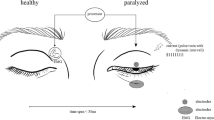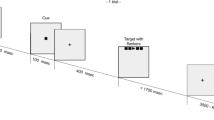Abstract
We investigated the changes in cervical (cVEMP) and ocular (oVEMP) vestibular evoked myogenic potentials in response to differing stimulus durations. cVEMPs (n = 12 subjects) and oVEMPs (n = 13 subjects) were recorded using air-conducted (AC: 500 Hz) and bone-conducted (BC: 500 Hz) tone burst stimuli with durations varying from 2 to 10 ms. BC stimulation was applied both frontally and to the mastoid. AC cVEMPs showed an increase in amplitude with stimuli up to 6-ms duration associated with a prolonged latency, as previously reported. In contrast, AC oVEMP amplitude decreased with increasing stimulus duration. BC stimuli showed no significant increase in amplitude with increasing stimulus duration for either reflex using either location of stimulation. BC cVEMPS following forehead stimulation showed a significant decrease as duration increased, and BC oVEMPs to mastoid stimulation were largest at 2 ms and decreased thereafter. We conclude that an increase in amplitude with increasing stimulus duration, using 500 Hz stimuli, only occurs for AC cVEMPs. There is no definite benefit in using longer stimuli than 2 ms for BC or oVEMP studies. Shorter stimuli also minimise subject exposure to sound and vibration.




Similar content being viewed by others
References
Cheng Y-L, Wu H-J, Lee G-S (2012) Effects of plateau time and ramp time on ocular vestibular evoked myogenic potentials. J Vestib Res 22:33–39
Colebatch JG, Rothwell JC (2004) Motor unit excitability changes mediating vestibulocollic reflexes in the sternocleidomastoid muscle. Clin Neurophysiol 115:2567–2573
Curthoys IS, Kim J, McPhedran SK, Camp AJ (2006) Bone conducted vibration selectively activates irregular primary otolithic vestibular neurons in the guinea pig. Exp Brain Res 175:256–267
Eccles JC (1931) Studies on the flexor reflex III. The central effects produced by an antidromic volley. Proc R Soc Lond B 107:557–585
Eccles JC (1964) The physiology of synapses. Springer, Heidelberg
Eccles JC, Sherrington CS (1931) Studies on the flexion reflex V. General Conclusions. Proc R Soc Lond B 107:597–605
Halmagyi GM, Yavor RA, Colebatch JG (1995) Tapping the head activates the vestibular system: a new use for the clinical tendon hammer. Neurology 45:1927–1929
Iwasaki S, McGarvie LA, Halmagyi GM, Burgess AM, Kim J, Colebatch JG, Curthoys IS (2007) Head taps evoke a crossed vestibulo-ocular reflex. Neurology 68:1227–1229
Koester J (1991) Passive membrane properties of the neuron. In: Kandel ER, Schwartz JH, Jessell TM (eds) Principles of neural science, 3rd edn. Prentice Hall, New Jersey, pp 95–103
Kushiro K, Zakir M, Ogawa Y, Sato H, Uchino Y (1999) Saccular and utricular inputs to SCM motoneurons of decerebrate cats. Exp Brain Res 126:410–416
McCue MP, Guinan JJ (1994) Acoustically responsive fibers in the vestibular nerve of the cat. J Neurosci 14:6058–6070
Rosengren SM, Todd NPM, Colebatch JG (2005) Vestibular-evoked extraocular potentials produced by stimulation with bone conducted sound. Clin Neurophysiol 116:1938–1948
Rosengren SM, Todd NPM, Colebatch JG (2009) Vestibular evoked myogenic potentials evoked by brief interaural head acceleration: properties and possible origin. J Appl Physiol 107:841–852
Rosengren SM, Welgampola MS, Colebatch JG (2010) Vestibular evoked myogenic potentials: past present and future. Clin Neurophysiol 121:636–651
Saunders DB (1999) Electrophysiologic study of disorders of neuromuscular transmission. In: Aminoff MJ (ed) Electrodiagnosis in clinical neurology, 4th edn. Churchill Livingstone, Philadelphia, pp 303–321
Todd NPM, Rosengren SM, Aw ST, Colebatch JG (2007) Ocular vestibular myogenic potentials (OVEMPs) produced by air- and bone-conducted sound. Clin Neurophysiol 118:381–390
Weber KP, Rosengren SM, Michels R, Straumann D, Landau K (2012) Single motor unit activity in human extraocular muscles during the vestibulo-ocular reflex. J Physiol 590:3091–3101
Welgampola MS, Colebatch JG (2001) Characteristics of tone burst-evoked myogenic potentials in sternocleidomastoid muscles. Otol Neurotol 22:796–802
Acknowledgments
This work was supported by the Garnett Passe and Rodney Williams Memorial Foundation and the National Health and Medical Research Council of Australia.
Author information
Authors and Affiliations
Corresponding author
Rights and permissions
About this article
Cite this article
Lim, L.J.Z., Dennis, D.L., Govender, S. et al. Differential effects of duration for ocular and cervical vestibular evoked myogenic potentials evoked by air- and bone-conducted stimuli. Exp Brain Res 224, 437–445 (2013). https://doi.org/10.1007/s00221-012-3323-1
Received:
Accepted:
Published:
Issue Date:
DOI: https://doi.org/10.1007/s00221-012-3323-1




